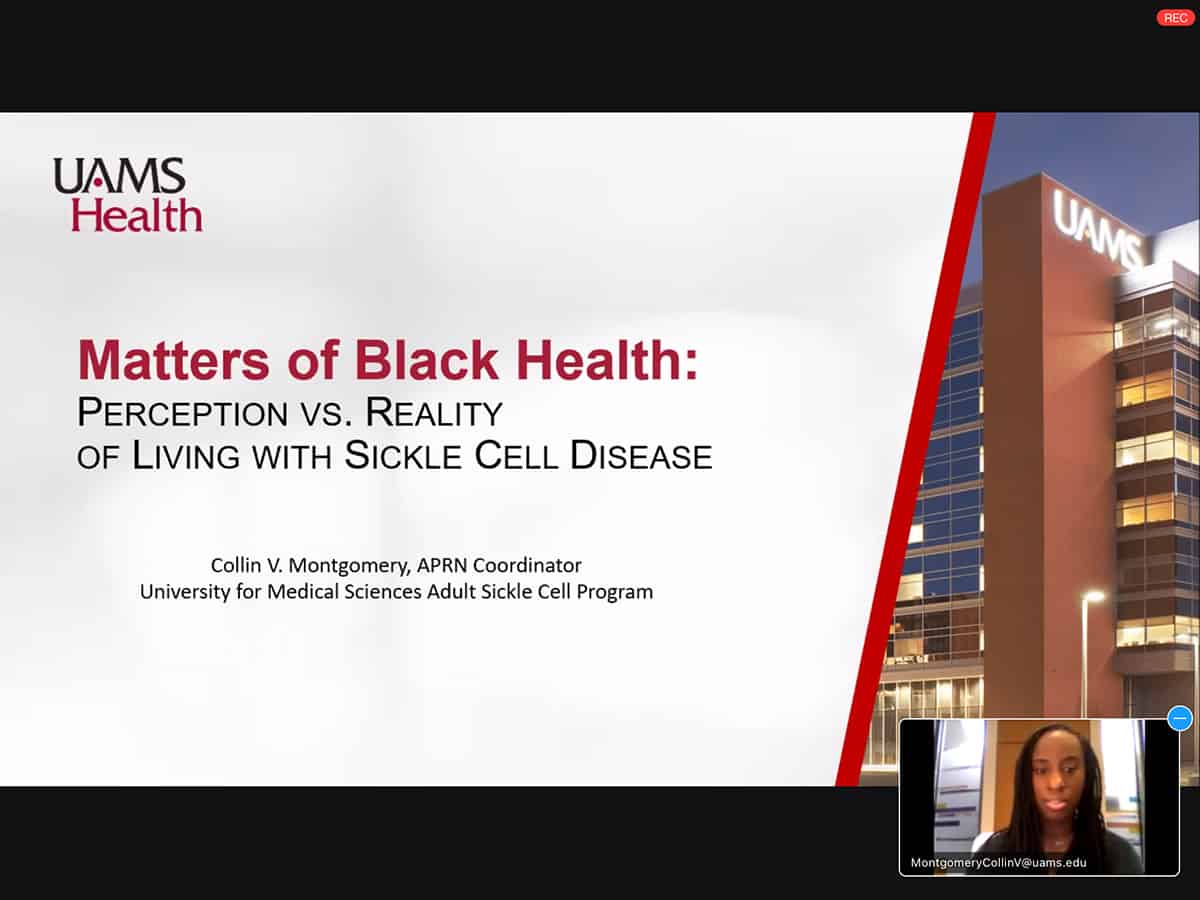Symposium Spotlights Social Burdens of Sickle Cell Disease Treatment
| Racial bias, the opioid crisis and the stigma of suspected drug use often make getting access to treatment a frustrating struggle for adult sickle cell patients.
In a short video that opened the UAMS Sickle Cell Symposium on Feb. 2, sickle cell disease patients spoke about the attitudes of physicians and nurses that often seem to stand in their way of getting access to treatment for pain crises caused by the disease.
“When they don’t believe me, I assume they think I am drug-seeking and only want the medications,” one young woman named Kennede said. “Actually, I hate taking pain medications, and only go to the hospital when I absolutely need them.”
Sponsored by the UAMS Adult Sickle Cell Clinical Program, the symposium was streamed live on Zoom this year. Thirty participants made up the online audience.
Stigma and bias mean “the burden of illness becomes greater than it should be,” said Sarah Council, Ph.D., one of three presenters at the symposium. She is a research writer for the UAMS Division of Hematology and Oncology.
“In a study of 77 sickle cell patients, they found significant associations between the measure of stigma and their depressive symptoms,” Council said. “Patients reported greater stigma and higher scores on a depression scale. It’s a self-feeding mechanism of stigma and racial discrimination.”
The overwhelming majority of sickle cell disease patients are Black.
Sickle cell disease is a group of inherited red blood cell disorders. Healthy red blood cells are round and travel through small blood vessels to carry oxygen throughout the body. With sickle cell disease, the red blood cells become hard and sticky, and result in a C-shape or “sickle.” When sickle cells travel to small blood vessels, they get trapped and block blood flow to the area. This results in pain and may lead to other problems such as infection, acute chest syndrome and stroke.
During a pain crisis, sickle cell disease patients often seek immediate treatment for their pain in hospital Emergency Departments, where they are seen by physicians or resident physicians who have little experience treating patients with sickle cell disease.
“People like us who have had sickle cell their entire lives may not express pain the same way as someone else,” Kennede said in the video. “We might not cry or crawl on the floor or anything, our pain tolerance is very high, so you can’t see we’re in pain sometimes. That’s the case with me.”
Council said clinicians in those settings often are skeptical of pain complaints and suspect sickle cell patients are merely seeking drugs. The national opioid crisis has brought increases in opioid-use related deaths and added to their hesitancy in prescribing pain medications.
“When you think about the overlay of race onto the families of my patients with sickle cell disease, it’s very real and affects them financially,” said Suzanne Saccente, M.D. “It affects their jobs and all aspects of their lives and then we have a life-threatening disease that worsens as they age. Now, we’ve overlaid the opioid crisis on top of that in the last five to 10 years. It’s made their ability to receive care that much harder.”
Also a presenter at the symposium, Saccente is a pediatric hematologist and medical director of the Sickle Cell Program and Apheresis Program at Arkansas Children’s Hospital.
She said the bias even extends into research funding.
Cystic fibrosis is a disease of the lung that affects primarily Caucasian people, and affects a third fewer patients than sickle cell disease does, Saccente said. However, when it comes to research funding, cystic fibrosis receives seven to 11 times more research funding than sickle cell disease.
Because sickle cell disease is a genetic disease that many patients begin to experience in infancy or childhood, by the time they are adults they have gained personal experience managing their disease and knowledge of the most effective, specific ways of treating a pain crisis. They often will ask for a specific drug or drugs by name and suggest a dosage, which can lead to a physician with little experience treating sickle cell disease to suspect they are drug seeking, said Collin Montgomery, APRN, coordinator of the UAMS Adult Sickle Cell Disease Clinical Program.
“A patient being able to request a specific medicine at a certain dose should be something we expect as health care providers. I don’t want to reinvent the wheel,” Montgomery said. “Plans should be individualized to each patient’s needs. There isn’t a one size fits all treatment with sickle cell patients.”
Saccente said she tries to reach medical students early in their education and teach them about the disease before they encounter a sickle cell patient.
“To counter bias, there has to be more education pushed down from the top,” Montgomery said. “Unfortunately, a lot of people are unaware of their bias. In taking care of sickle cell patients, I say ‘Know your bias and know how to manage it.’ We’re human and all have potential for bias. We have a team approach that provides some checks and balances.”
Part of helping patients communicate their needs to physicians and nurses to facilitate their treatment also involves some patient education, too.
“I hate to say it, but we even give them scripts. ‘If this happens, then you should say this.’ A lot of time we have to tell them what not to do, to not get angry or yell. We help them to ward off behaviors that fuel stigma,” Montgomery said.
